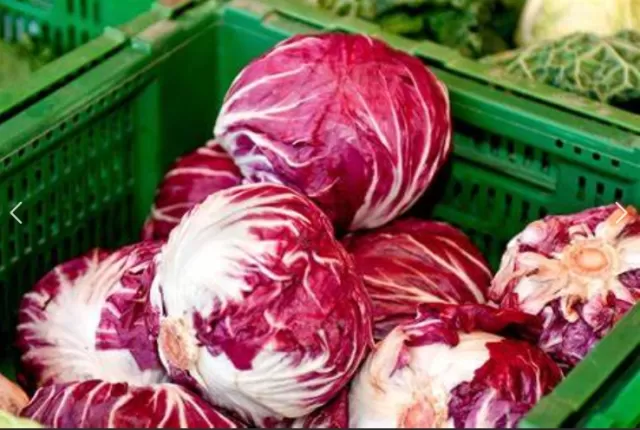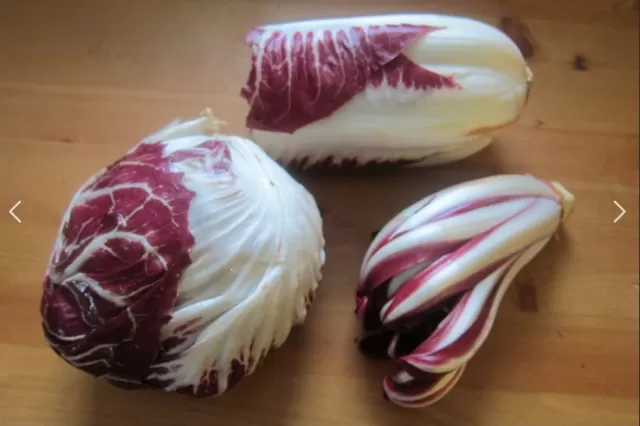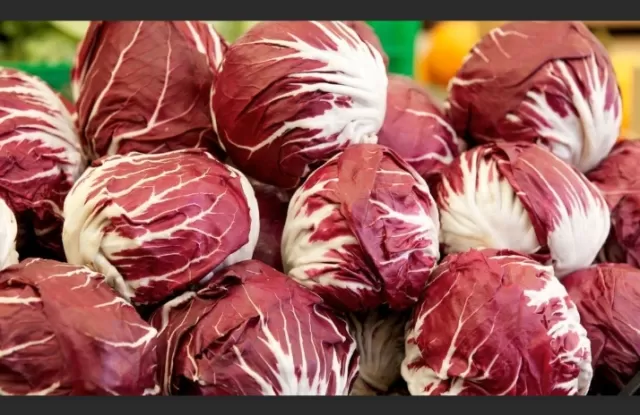Radicchio: The Vibrant and Crunchy Winter Vegetable. In the realm of winter greens, radicchio emerges as the undeniable “it girl,” captivating taste buds and adding a burst of vibrant color to seasonal dishes. As a distinctive member of the chicory family, radicchio boasts uniqueness in every aspect, from its characteristic bitter flavor to the visually stunning array of varieties it presents. This winter wonder doesn’t just enhance the culinary landscape; it transforms it.
Whether enjoyed in its raw, crisp form or elevated through various cooking techniques, radicchio requires only a few complementary seasonal flavors to showcase its true brilliance. Its bitter undertones, coupled with a captivating aesthetic, make it a versatile ingredient that can shine in diverse culinary creations.
What sets radicchio apart even further is its ability to thrive in frigid temperatures that challenge many other crops. This resilience makes radicchio a staple in winter recipes, offering a spectrum of possibilities—from refreshing salads that awaken the palate to grilled or roasted wedges that stand as a robust and flavorful side dish.
In the following exploration, delve into the main varieties of radicchio, each with its own distinctive charm. Additionally, discover some of the most delightful ways to prepare this wonder vegetable, promising to inject a pop of color and culinary excitement into even the gloomiest winter days. Join us on a journey celebrating radicchio’s role as winter’s culinary muse, a source of inspiration for creating memorable and vibrant meals throughout the season.
Unveiling the Essence of Radicchio: A Storied Chicory Plant

Radicchio, a chicory plant deeply ingrained in Italian agricultural history, has been cultivated for centuries, as affirmed by Franco Fubini, CEO and founder of Natoora, a produce retailer with a direct link to farmers.
In the annals of Italy’s agricultural heritage, each region historically boasted its distinctive radicchio variety, a tradition still evident in the nomenclature of different types like Treviso, Castelfranco, and Chioggia.
Although radicchio is now cultivated in various countries, its roots and the cultural tapestry surrounding it remain an integral part of Italy’s identity.
Thriving in the chill of winter, radicchio plants play a crucial role in safeguarding sandy soils during a season when other crops are scarce. Through meticulous cultivation practices, the inherent bitterness of the radicchio plant is tempered, rendering it exquisitely palatable and underscoring its significance in Italian culinary traditions.
Decoding Radicchio\’s Bitterness: A Culinary Journey
The notion of radicchio’s bitterness might have dissuaded you from exploring this winter delicacy, but let’s delve into the science behind it and entice you to savor its unique flavor profile.
The bitterness is a result of a chemical compound naturally released when the leaves are broken down, offering a distinctive taste that beckons culinary exploration.
The cultivation method significantly influences the bitterness of each radicchio variety, according to insights from Fubini.
Small-scale growers, for instance, employ a labor-intensive approach, waiting until the first frost to transplant chicories for a second growth stage, leading to mature plants with a crisp texture and a complex, bittersweet flavor. In contrast, commercial growers often opt for self-blanching seeds, resulting in a duller color, drooping texture, and a more pronounced bitter taste.
An alternative method is the forced growing technique, where harvested plants with intact roots are exposed to controlled conditions, reviving without the ability to photosynthesize.
This yields radicchio with a perfectly balanced, not-too-bitter flavor profile.
Embracing or moderating the bitterness is also an art in radicchio appreciation.
Beyond the cultivation technique, the bitterness varies with preparation. Raw radicchio tends to be more bitter, while cooking releases natural sugars, tempering the intensity.
Just like onions, soaking chopped radicchio in cold water proves effective in mitigating bitterness, especially when enjoying it in its raw form. So, whether you choose to embrace or temper the bitterness, radicchio offers a diverse and intriguing culinary experience.
Exploring the Rich Tapestry of Radicchio: Five Distinct Varieties

As the calendar flips to November, the culinary landscape becomes adorned with an array of chicories, each offering a unique character.
Here, we spotlight five noteworthy types that deserve a place on your gastronomic radar:.
Chioggia: Resembling a diminutive head of red cabbage both on the exterior and within, Chioggia is a ubiquitous presence in supermarkets.
Renowned for imparting an astringent bite to dishes, it stands as a versatile addition to various culinary creations.
Castelfranco: Distinguished by its unmistakably speckled leaves, Castelfranco presents a very pale green hue and boasts a notably mild, creamy flavor.
Ideal for elevating simple salads, its delicate nature allows it to complement a range of culinary combinations.
Treviso: Sporting an oblong shape akin to Chioggia, Treviso leaves share a similar style but offer a more subdued overall flavor.
Embracing them in crudité platters proves delightful, as their shape facilitates perfect scoops for dips and sauces or serves as an elegant vessel for cheese and charcuterie.
Tardivo: The resplendent Tardivo variety captivates with its deep purple leaves that gracefully curl around the vegetable’s head.
This robust variety undergoes a second stage of growth, a step often overlooked in commercial cultivation. Yet, this meticulous process yields a more authentic flavor and sturdier leaves, adding substance to culinary endeavors.
Rosa del Veneto: This rosy pink variety, known as Rosa del Veneto, unfolds its tender leaves with a gradual development of color.
Considered a specialty option, its leaves embody a delicate balance of mild bitterness and a hint of sweetness. Best enjoyed in its raw form, the leaves retain their enchanting pink hues, offering a visually and gastronomically appealing addition to dishes.
Unlocking the Culinary Potential of Radicchio: Raw and Cooked Inspirations
Raw Brilliance: Indulge in the vibrant allure of raw chicories, elevating your winter salads to new heights.
Whether as a captivating mix in a warm bread salad or standing boldly on its own, adorned with a simple dressing, raw radicchio adds a burst of color and distinct flavor. For a harmonious balance, consider the addition of fatty Parmesan cheese to temper the inherent bitterness. Thinly sliced radicchio finds its place atop warm chicken cutlets, where the leaves gracefully wilt against the heat, transforming into a delightfully pleasant accompaniment.
Cooked Mastery: Unleash the full potential of radicchio, especially the more robust varieties, through the art of cooking.
Let the greens wilt into warm pasta for a comforting embrace of flavors, or roast wedges in a hot oven to unlock their rich, savory essence. Most radicchio varieties gracefully withstand the heat, retaining their aesthetic appeal when sautéed or grilled.
Flavor Pairing Symphony: Embrace the wisdom of “what grows together goes together,” as winter ingredients seamlessly complement the unique profile of radicchio.
Given its inherent bitterness, crafting flavor pairings with elements that are sweet, acidic, and/or fatty becomes paramount. Explore the culinary canvas by combining radicchio with winter companions, creating a Symphony of Flavors that brings out the best in this versatile green.
Preserving the Freshness of Radicchio: A Guide to Proper Storage

To ensure the longevity and freshness of radicchio, employing the right storage method is crucial.
Follow these recommendations from Fubini for an optimal storage experience:.
Covering Heads: Shield radicchio heads from excessive light exposure by covering them with an opaque material.
A practical choice for this purpose is a plastic bag, which serves to prevent continued photosynthesis. This step is essential in maintaining the quality and flavor of the radicchio.
Refrigeration: Store the covered radicchio heads in the refrigerator.
The cool temperature helps to slow down any potential deterioration, preserving the crispness and taste of the leaves.
By adhering to these simple yet effective storage practices, you can extend the shelf life of radicchio and enjoy its culinary versatility over an extended period.
*The information is for reference only.